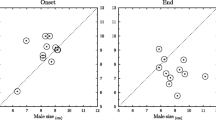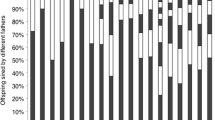Abstract
In order to estimate the three independent components of mating behaviour, sexual selection in females, sexual selection in males and mating pattern, we studied the distribution of shell colour morphs among mating pairs and between copulating and non-copulating snails in four subsamples of a natural population ofL. mariae. The colour of the shell, the sex and a qualitative estimate of age was recorded for every snail. We found sexual selection acting against one of the two commonest colours (yellow) among the young females. However, in males none of the eight shell colour morphs was favoured during matings. Male sexual choice or differences in female sexual activity may cause the sexual fitness disadvantage of yellow females. Moreover, individuals of different colour morphs did not mate at random, rather dissasortatively. A behavioural choice among shell colour morphs or a non-random microdistribution of the morphs may cause the departure from random mating in this population.
Similar content being viewed by others
References
Anderson, W.W. & P.R. McGuire, 1978. Matting pattern and mating success ofDrosophila pseudoobscura karyotypes in large experimental populations. Evolution 32: 416–423.
Arnold, S.J. & M.J. Wade, 1984. On the measurement of natural and sexual selection: applications. Evolution 38: 720–734.
Cain, A.J. & P.M. Sheppard, 1950. Selection in the polymorphic land snailCepaea nemoralis. Heredity 4: 275–294.
Cain, A.J. & P.M. Sheppard, 1954. Natural selection inCepaea. Genetics 39: 89–116.
Cain, A.J., J.M. King & P.M. Sheppard, 1960. New data on the genetics of polymorphism in the snailCepaea nemoralis L. Genetics 45: 393–411.
Clarke, B., 1962. Natural selection in mixed populations of two polymorphic snails. Heredity 17: 319–345.
Clark, A.G. & M.W. Feldman, 1981. The estimation of epistasis in components of fitness in experimental populations ofDrosophila melanogaster. II. Assessment of meiotic drive, viability, fecundity and sexual selection. Heredity 46: 347–377.
Cook, L.M., 1971. Coefficients of natural selection. Hutchinson University Library, London.
Cook, L.M., 1986. Polymorphic snails on varied backgrounds. Biol. Journ. Linn. Soc. 29: 89–99.
Cook, L.M. & S.D. Garbett, 1992. Selection in the polymorphic mangrove snailLittoraria pallescens, pp. 247–254 in Proceedings of the Third International Symposium on Littorinid Biology, edited by J. Grahame, P.J. Mill & D.G. Reid. The Malacological Society of London, London.
Diver, C., 1940. The problem of closely related species living in the same area, in The New Systematics, edited by J.S. Huxley, O.U.P., London.
Ekendabl, A., 1994. Factors important to the distribution of colour morphs ofLittorina mariae Sacchi & Rastelli in non-tidal area. Ophelia 40: 1–12.
Endler, J.A., 1986. Natural selection in the wild. Princeton University Press, Princeton, New Jersey.
Erlandsson, J. & K. Johannesson, 1994. Sexual selection on female size in a marine snail,Littorina littorea (L.). J. Exp. Mar. Biol. Ecol. 181: 145–157.
Goodhart, C.B., 1987. Why are some snails visibly polymorphic, and others not. Biol. Journ. Linn. Soc. 31: 35–58.
Goodwin, B.J. & J.D. Fish, 1977. Inter and intra specific variation inL. obtusata andL. mariae. J. Moll. Stud. 43: 241–254.
Hartl, D.L. & A.G. Clark, 1989. Principles of Population Genetics, Sinauer Associates, Inc. Massachusetts.
Hedrick, P.W. & E. Murray, 1983. Selection and Measures of fitness, pp. 61–105, in The Genetics and Biology ofDrosophila. Vol. 3d, edited by M. Ashburner, H.L. Carson and J.N. Thompson. Academic Press, London.
Heller, J., 1975. Visual selection of shell colour in two littoral prosobranchs. Zool. J. Linn. Soc. 56: 153–170.
Johannesson, K., E. Rolán-Alvarez & A. Ekendahl, in press. Incipient reproductive isolation between two sympatric morphs of the intertidal snailLittorina saxatilis. Evolution 47: 1770–1787.
Knoppien, P., 1985. Rare male mating advantage: a review. Biological Review 60: 81–117.
Koening, W.D. & S.S. Albano, 1986. On the measurement of sexual selection. Am. Nat. 127: 403–409.
Merrell, D.J., 1950. Measurement of sexual isolation and selective mating. Evolution 4: 326–331.
Murray, J., 1975. The genetics of Mollusca, pp. 3–31, in Handbook of Genetics 3. R.C. King, ed. Plenum Press, London.
O'Donald, P., 1980. Genetic models of sexual selection. Cambridge University Press, London.
Prout, T., 1965. The estimation of fitnesses from genotypic frequencies. Evolution 19: 546–551.
Reid, D.G., 1987. Natural selection of apostasy and crypsis acting on the shell colour polymorphism of a mangrove snail,Littoraria filosa (Sowerby) (Gastropoda: Littorinidae). Biol. Journ. Linn. Soc. 30: 1–24.
Reimchen, T.E., 1974. Studies on the biology and colour polymorphism of two sibling species of marine gastropod (Littorina). Ph.D. Thesis, University of Liverpool, Liverpool.
Reimchen, T.E., 1979. Substrate heterogeneity, crypsis and colour polymorphism in an intertidal snail (Littorina mariae). Canadian Journal of Zoology 57: 1070–1085.
Reimchen, T.E., 1981. Microgeographical variation inLittorina mariae Sacchi & Rastelli and taxonomic considerations. Journ. Conch. Lond. 30: 341–350.
Reimchen, T.E., 1989. Shell colour ontogeny and tubeworm mimicry in a marine gastropodLittorina mariae. Biol. Journ. Linn. Soc. 36: 97–109.
Rolán, E. & J. Templado, 1987. Consideraciones sobre el complejoLittorina obtusata-mariae (Mollusca, Gastropoda, Littorinidae) en el Noroeste de la península lbérica. Thalassas 5: 71–85.
Rolán-Alvarez, E., 1992. A method of breedingLittorina obtusata (L.) andL. mariae Sacchi & Rastelli and preliminary results, pp. 163–168, in Proceedings of the third International Symposium on littorinid biology, edited by J. Grahame, P.J. Mill & D.G. Reid. The Malacological Society of London, London.
Rolán-Alvarez E., 1993. Estructura genética y selección sexual en poblaciones naturales de 2 especies gemelas del géneroLittorina. Ph.D. Universidad de Santiago de Compostela. Spain.
Rolán-Alvarez, E., C. Zapata & G. Alvarez, 1995a. Distinct genetic subdivision in sympatric and sibling species of the genusLittorina (Gastropoda: Prosobranchia). Heredity 74: 1–9.
Rolán-Alvarez, E., C. Zapata & G. Alvarez, 1995b. Multilocus heterozygosity and sexual selection in a natural population of the marine snailLittorina mariae (Gastropoda: Prosobranchia). Heredity 75: 17–25.
Sacchi, C., 1966. Contribution a l'étude des rapports entre variabilité et écologie chez un prosobranche intertidalLittorina obtusata (L.). V.-Recherches dans le plymouth sound (Angleterre S.-W.). Cahiers de Biologie Marine 7: 281–294.
Santos, M., C. Tarrio, C. Zapata & G. Alvarez, 1986. Sexual selection on chromosomal polymorphism inDrosophila subobscura. Heredity 57: 161–169.
Sergievsky, S.O., 1992. A review of ecophysiological studies of the colour polymorphism ofLittorina obtusata (L.) andL. saxatilis (Olivi) in the White sea, pp. 235–246, in Proceedings of the third International Symposium on littorinid biology, edited by J. Grahame, P.J. Mill & D.G. Reid. The Malacological Society of London, London.
Spieth, H.T. & J.M. Ringo, 1983. Mating behavior and sexual isolation inDrosophila, in The Genetics and Biology ofDrosophila. vol 3c. edited by M. Ashburner, H.L. Carson & J.N. Thompson. Academic Press. London.
Taylor, J.W., 1914. Monograph of the land and freshwater mollusca of the British Isles 3. Taylor ed., Leeds.
Zahavi, A., 1991. On the definition of sexual selection, Fisher's model, and the evolution of waste and of signals in general. Anim. Behav. 42: 501–503.
Zapata, C., G. Gajardo & J.A. Beardmore, 1990. Multilocus hetcrozygosity and sexual selection in the brine shrimpArtemia franciscana. Mar. Ecol. Progr. Ser. 62: 211–217.
Zaykin, D.V. & A. Pudovkin, 1993. Two programs to estimate significance ofX 2 values using pseudo-probability tests. J. Hered. 84: 152.
Author information
Authors and Affiliations
Rights and permissions
About this article
Cite this article
Rolán-Alvarez, E., Ekendahl, A. Sexual selection and non-random mating for shell colour in a natural population of the marine snailLittorina mariae (Gastropoda: Prosobranchia). Genetica 97, 39–46 (1996). https://doi.org/10.1007/BF00132579
Received:
Accepted:
Issue Date:
DOI: https://doi.org/10.1007/BF00132579




